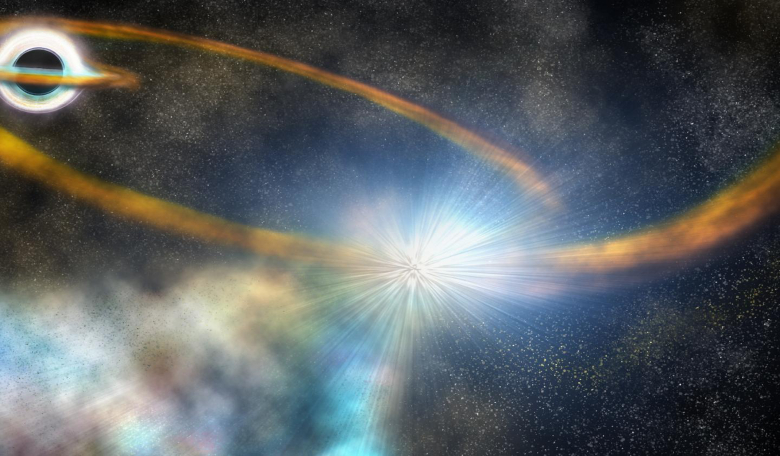It would take an incredible amount of force and energy to rip a giant ball of gas apart, one that is capable of generating nuclear fusion reactions in its core, but for the first time, NASA's planet-hunting Transiting Exoplanet Survey Satellite (TESS) has watched it happen. The bringer of doom is a supermassive black hole that sits at the centre of a galaxy called 2MASX J07001137-6602251 located around 375 million light-years away and its unlucky victim is a nameless star that may have been similar in size to our Sun.
This incredible event, called a tidal disruption event, though in this case was more of a tidal destruction event, is also incredibly rare and occurs once every 10,000 to 100,000 years in a galaxy the size of our own Milky Way. Supernovae, by comparison, happen every 100 years or so.
Fortunately, scientists have been able to get an unprecedented look at the extermination process as telescopes on and off the globe, such as NASA's Neil Gehrels Swift Observatory, Swift, ESA's XMM-Newton and ground-based 1-metre telescopes in the global Las Cumbres Observatory network, quickly followed-up TESS’s initial observations to produce the most detailed look yet at the early stages of one of these star-destroying occurrences.
"TESS data let us see exactly when this destructive event, named ASASSN-19bt, started to get brighter, which we've never been able to do before," said Thomas Holoien, a Carnegie Fellow at the Carnegie Observatories in Pasadena, California and lead author of a paper recently submitted to The Astrophysical Journal. "Because we identified the tidal disruption quickly with the ground-based All-Sky Automated Survey for Supernovae (ASAS-SN), we were able to trigger multiwavelength follow-up observations in the first few days. The early data will be incredibly helpful for modeling the physics of these outbursts."
This newfound TDE, called ASASSN-19bt, is one of only a small number (around a handful) of TDEs that have been discovered before they reached peak brightness and thanks to it being in what's called TESS' 'Continuous Viewing Zone,' meaning scientists have observations of it every 30 minutes going back months, it was found just a few days after it started to brighten.
The light given off during this process before it tapers off, can help reveal information about the speed and chemical composition of material from the chewed-up star, while also giving astronomers a better understanding of the physics of the black hole and the forces driving these phenomena.
"The early TESS data allow us to see light very close to the black hole, much closer than we've been able to see before," said Patrick Vallely, a co-author and National Science Foundation Graduate Research Fellow at OSU. "They also show us that ASASSN-19bt's rise in brightness was very smooth, which helps us tell that the event was a tidal disruption and not another type of outburst, like from the centre of a galaxy or a supernova."
Did the light tell the team anything else about the event? It was once thought that all TDEs would look the same but it turns out that ASASSN-19bt is unusual in several of ways.
Its host galaxy is more dust-filled and younger than has previously been observed for other TDE events and it’s temperature dropped by about 50 percent, from around 40,000 to 20,000 degrees Celsius (71,500 to 35,500 degrees Fahrenheit), over a few days. It's the first time such an early temperature decrease has been seen in a TDE before, although a few theories have predicted it.
ASASSN-19bt did live up to expectations as far as X-ray emission was concerned however. Events such as these usually produce lower X-ray emission, as ASASSN-19bt did, but higher UV light; a phenomena scientists don't fully understand why, but some think it is because the light bounces through the newly created debris and loses energy, “or maybe the disk forms further from the black hole than we originally thought and the light isn't so affected by the object's extreme gravity," said S. Bradley Cenko, Swift's principal investigator at NASA's Goddard Space Flight Center in Greenbelt, Maryland.
In total, astronomers have observed only about 40 tidal disruptions so far, now, thanks to TESS’s ability to observe ASASSN-19bt so early on, and in the continuous viewing zone where it could be watched for so long, the information gathered on this cataclysmic process will improve astronomers' ability to identify future TDEs and differentiate them from other celestial events.
"Future collaborations with observatories around the world and in orbit will help us learn even more about the different outbursts that light up the cosmos,” concluded Padi Boyd, a TESS project scientist at Goddard.
If in the meantime, if you want to see a striking visualisation of how gravity distorts our view of a black hole, warping its surroundings as if seen in a carnival mirror, NASA has produced a fantastic simulation of a turbulent disk of gas churning around a black hole showing how its extreme gravity alters the paths of light coming from different parts of the disk to produce a warped image. You can find the link to the simulation here.











